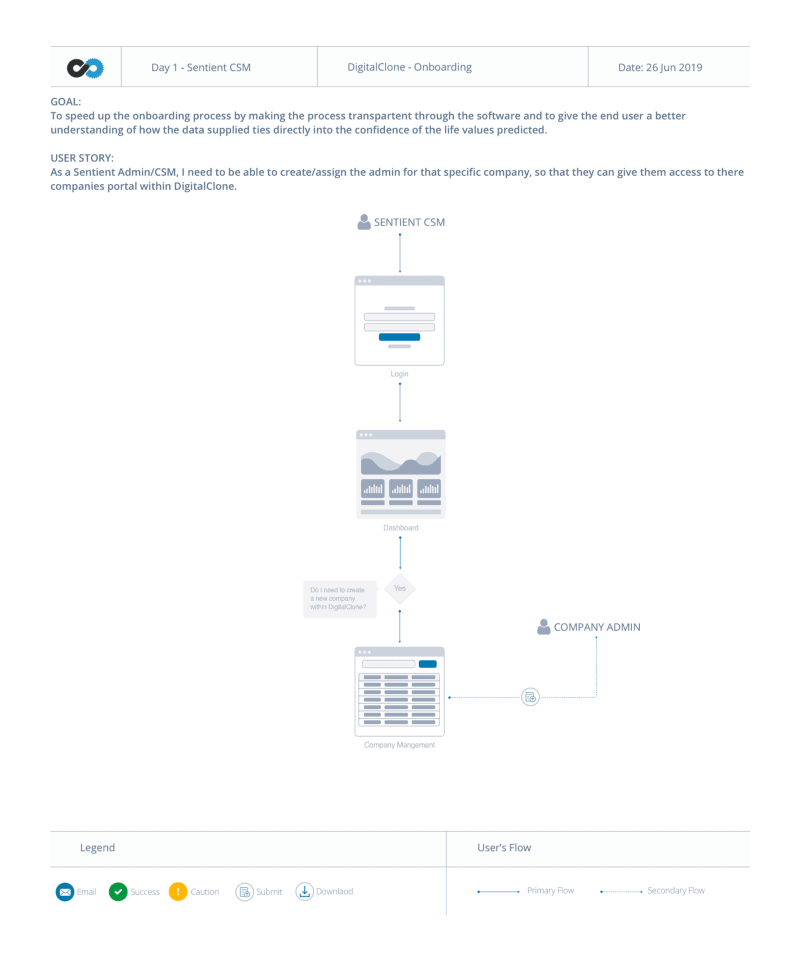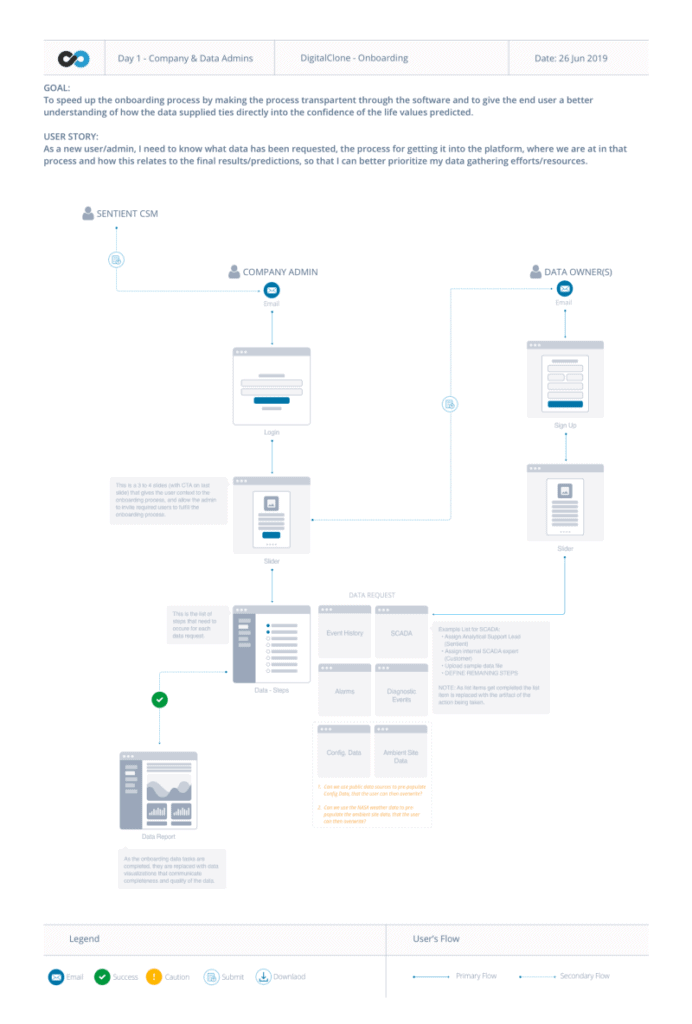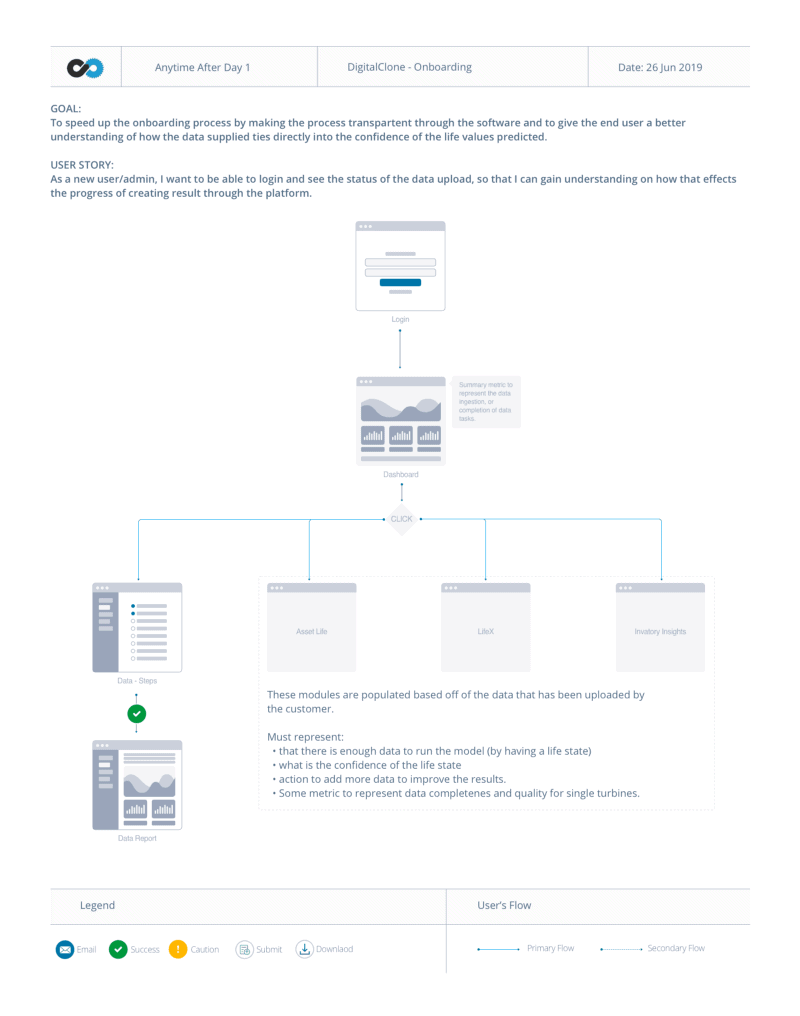Big data requires user based solutions that integrate all stakeholders in order to optimize the workflow and communication for all.
Initiative
It was identified the user found minimal to no value from the software the first time they logged in. The users did not find any value until the onboard process of the gig data was completed, this could take 3 to 4 months.
This lead to me researching the current onboard process. I wanted better understanding on how the user interface (UI) could guide both internal and external users through the onboard process. Additionally, I wanted to determine what value could be provided as steps of the onboard process are completed.
Background
This is a software platform that provided predictive analytics for industrial equipment. The principal customer for this technology was operators of wind turbines.
The software provided predictive values for when and how individual components (bearings and gears) will fail. To provide these values, the customer is required to provide terabytes worth of historical data that comes in structured and unstructured formats for one wind turbine.
Once the data has been collected by the customer, it would then be cleaned and configured, so it could be run in the predictive models.
Goal
The research goal was to clearly identify the pain points of the big data onboard process from the perspective of both internal and external users. To accomplish this, I interviewed everyone that was “known” to be involved with this data collection process. This was 15 different users. Ten of these people were internal users representing software engineering, data analytics and the customer success departments. The remaining five people were the external users from one specific customer that was going through the onboard process. Through this qualitative research, I validated user persona information and identified the user journey through this manual process.
These are the questions that I looked to answer during this research.
Internal Discovery:
- What is the process to ingest data and produce a value?
- How do we communicate status and issues on data ingestion with customers?
- What are the current pain points with the current process?
- What is the frustration felt by the team?
External (Customer) Discovery:
- What is the process to collect all the requested data?
- What obstacle exist to obtain data?
- How many people are involved to collect data?
- How can we refine and simplify the data ask?
- How can keep user engaged as the analytic models are built and refined?
Key Findings
Improve Communication
Communication between all parties was a convoluted process that is not centralized and happens over multiple channels, such as: group meetings, phone calls, emails, side conversations and chat messages. The focus of all these communication channels is around the data requirement, the status of the data ingestion and what needs to happen to clean the data.
Speed Up Timeline
Once a customer signs up to use the software tool, they are required to go through the lengthy onboard process before they they see results in the software. This timeline can range three to four months. The external users find this frustrating, because they are required to put substantial work into collecting and formatting data and do not see any immediate results from that efforts.
Additionally, not all the data that is requested is available, or exists. With the current data requirements and process this is another blocker from users being able to gain value from the software tool.
Identified New User
The conversation with external users revealed that there are more people participating in the data collection process than was previously defined. For example, our primary contact would reach out to one person to help collect data for one wind turbine site, and that person would then reach out to two or three more people. This is an opportunity to define additional user personas and to create functionality for these users within the software.
Results
The raw results of these interviews (interview recordings and notes) where distributed to the entire company. Additionally, there was a formal presentation to all internal stakeholders to give them more context to the problems that were uncovered. The next step from this point would be to take this information to a Design Sprint so solutions can be brainstormed and prototypes can be created and tested.
NOTE: At the time of this article publication the effort was reprioritized by Product leadership and we did not get to the prototyping phase.
For the formal presentations to the stakeholders, a preliminary wireframe was created to demonstrate how we can engage with user on day one along with interact with additional users within our customers organization.
These two wireframes show how a customer success manager could onboard a new customer, and customer admin, along with how that customer admin can then add additional users for specific roles related to the data. This would all revolve around a data status display that would be a constant report out on the state of the data that is being ingested by the software tool.


The third wireframe that is displayed below outlines an external user ability to interact with the software after day one. You will notice here that we are now calling out the other software functionality. The goal is to demonstrate to the external users that they build the value within the software as they continually contribute additional data points over time.

Business Value
First impressions mater. People make snap judgments. The Missouri University of Science and Technology revealed it takes just 50 milliseconds for users to form their first impressions of your site. Additionally, nearly one in four users will abandon a mobile app after using it just once.
Once a user has a bad experience with your software, that creates an opinion that sticks with them. This is why it is essential to give your user the right onboard experience for their role within your enterprise software.
A user is asked to take effort into using and downloading software. They do so with the expectation that it will make their day/job easier. Once they log in to the software, it’s crucial they feel rewarded right away.
For this specific case delivering final results is such a lengthy process and requires substantial participant from different user. Because of this, you need to ask what alternative value can be provided on day one?


